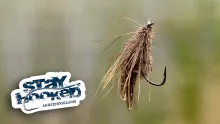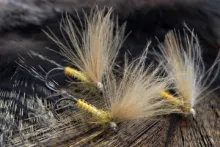A history of CDC in fly tying, as well as a wealth of patterns and techniques.
Updated or edited 6 months ago
A history of CDC in fly tying, as well as a wealth of patterns and techniques.
It would be a mistake to toss this book off as another niche "how-to" guide. Quite the contrary - this book is that (sort of) yet much more.
While many American authors have alluded to the fact that CDC flies are of European origin, few (none?) have gone beyond that simple statement to offer a glimpse of early CDC flies and their tyers. We owe Leon Links a debt of gratitude for putting down in print this history. American tyers in particular owe Stackpole Books a similar debt for bringing this book, originally published in the UK, to our shelves.
Links, through the work of Marc Petitjean, goes back to the early 1900's to dig up some of the first uses of CDC feathers in fishing flies in the Swiss Jura Mountain area. From there, he documents the development of these flies in France, where we learn it was Henri Bresson who gave us the phrase "Cul de Canard".
The bulk of the book is devoted to indivdual fly tyers and the use of CDC in their tying - mostly European tyers. I relish every chance I get to learn more about my fellow tyers across the Big Pond, so I was not at all disappointed to see so few US based tyers represented since many of them have already published their CDC techniques in various magazines, books, and videos. The value of this book to me, above the useful fly tying info, is the introduction to many fly tyers I have never encountered, or those that I have heard of but not been exposed to their work.
The book is not organized as many fly tying books are - according to fly tying technique, fly anatomy, or even fly style - so it is less useful as a reference as it could be. The index is similarly organized according to tyer and specific fly. If you flip through the book - you see many photographs of specific flies, but relatively few step-by-step instructional photos that will help you tie them. There are step-by-step photos, of course, but they seem less important to the book that the patterns themselves. While I enjoy reading a tyers thoughts on their flies and tying, I know some will miss a more detailed discussion of tying techniques or the ability to flip directly to the instruction on how to tie a loop wing emerger, for instance.
Most CDC flies tend to be simple in nature - impressionistic flies made up of just a few materials at most - yet some of the examples shown are rather complex in nature or use specialized techniques. I may have appreciated a smaller font which would have allowed more room for tying descriptions, fishing uses, or even theories on construction. While some photos show a single fly enlarged enough to show details, other photos show groups of several flies where the reader must guess at the methods used to tie them - if it was not obvious from the pattern descriptions.
It is also often the case that the pattern recipe is on a different page from the photo of the fly, which leads to plenty of page flipping. The book may have benefitted from a bit of organization in that regard, either leaving the fly photos and pattern recipes for an appendix at the back, or even at the end of chapters or subsections. Once a book is read through from cover to cover the first time, the worth of a book such as this is measured by its utility at the tying desk. Being able to quickly locate required information is an important trait of any fly tying book. In this regard, Tying Flies with CDC falls a little short.
While this book is directed at fly tyers, there is some mention of fishing CDC flies and the nuances of their use. A few pages at the end of the book deal with such topics as drying flies, avoiding the use of liquid floatants, and frequent fly changes. I would guess that the audience of this book already has a grasp on how to fish CDC flies and the book would not have missed these few pages.
In spite of these drawbacks, I believe any tyer who has an interest in CDC flies will find this book fascinating and well worth the cover price. A book like this serves as a reminder of how inventive fly tyers can be, and how many ways a simple material can be incorporated into fishing flies.
- Log in to post comments








Hi there,
I am a fl
Hi there,
I am a flyfisher from the Eifel Region and I love CDC flies as well. Consequently I bought the book by Leon Links 'Tying Flies with CDC' a couple of years ago. There is actually a chapter on the history of CDC flies and Maximilien Joset is mentioned indeed. I would definitely enjoy to learn mor about the history though.
Rolf,
As far as I
Rolf,
As far as I know this is the only book in English exclusively about CDC, so it might be the one. But I don't remember whether Maximilien Joset is mentioned in it. I don't have it right here, but can check when I get home to my books in a few days.
Martin
I did not know about
I did not know about this book but I think I should purchase it- if still available.
I tied the CDC probably before ever Fratnik, Petitjean and others did so, because I was fishing every year the famous Doubs river where I met the great flyfishers and flytiers. All what is left of these tiers is in my hands now- the originals.
When I was buying the old flies from Alain Joset, the grandson of Maximilien Joset (one of the inventors of CDC) he told me about a book, which was written in English, and where it is written about his father.
He did not know the name of the book and told me a copy may be at his mothers home.
May this be this book?
I Just went Fishing
I Just went Fishing in the river Kyll (Kyllburg Germany) and experianced that fish would only rise on Yellow tied CDC flies. I only had a Yellow thread and brown CDC and tied me a few sedges with that material, that resulted in lots of takes of little trout and little chub. I just bought this book, hope it 'll help me next time....